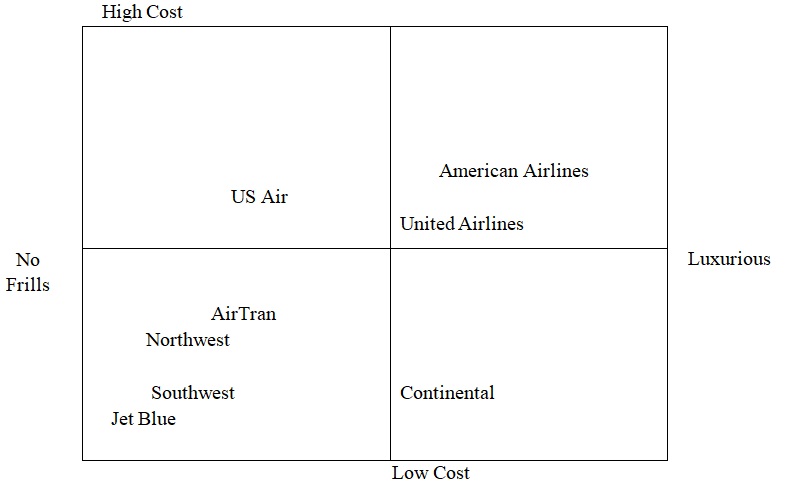This paper defines the positioning strategy for Southwest Airlines. In the United States, the airline industry is ever-growing. With advancement in newer technology, equipment and better competitive strategies, it has become difficult for airlines to stay on the top, or stay in the industry, for that matter.
The overall positioning strategy that Southwest has chosen for itself is the ‘less for much less’ strategy (Kotler & Armstrong, 2008). This means that Southwest does not offer much; it’s a no-frills airline. But it also does not charge a high price. It prices itself according to the service that it provides; it is a low-price airline. Therefore, it has positioned itself as the no-frills, low-price airline. Passengers fly without luxury; there is no food, no first class sections and no reserved seats. However, they pay an extremely low price for getting to their destinations along with their luggage (Kotler & Armstrong, 2008).
Its major competitive advantage is its lower prices. It has also gained an edge in hedging its fuel needs better than the other airlines. It is a no-frills airline and in many cases, this works for Southwest as a competitive edge. More importantly, its exciting and friendly atmosphere is a significant competitive advantage that many of the other network airlines do not offer or cannot pull it off. Other competitive advantages include just one type of plane for all flights; the Boeing 737 series, point-to-point flying, simple in-flight service, and a relatively happier workforce (Brancatelli, 2008).
Positioning Map Attributes
The two main attributes of the company are price and the other is frills attached within the flight. Based on these criteria, the positioning map is made below (U.S. Air Carriers, 2003).

Repositioning Strategy
One strategy that immediately hits the mind is starting a business class in their airplanes. This will be a new product available to the huge number of business people flying regularly and might give them a sense of pride travelling in a different class to the ordinary people. For the ordinary people an economy class can be started which will be priced slightly lower than the business class. The only difference between the two will be the level of service received for the business class will be better. (Kotler & Armstrong, 2008)
Another product that Southwest Airlines can develop is start international tours at a low price using several connecting flights as a source to keep the costs low. However cities closer to US should only be considered for such an initiation.
Southwest is the most popular domestic airline and carries the most number of passengers domestically. Focusing on the domestic market and giving the lowest fares, Southwest Airline has been able to gain a competitive advantage in the industry and is one of few profitable airlines today in the times of economic recession. Everywhere Southwest starts its flights, the fares of that destination from the competitors fall due to the competitiveness in the industry that Southwest brings (Pounds and Weil, 2001). However even with the intensity of low cost airlines in US, Southwest remains a market leader and does so by coming up with new marketing campaigns, serving the most profitable routes and reducing its costs.
References
Brancatelli, J. (2008). Southwest Airlines Seven Secrets for Success. Web.
Kotler, P. & Armstrong, G. (2008). Principles of Marketing. India: Prentice Hall.
Pounds, S. and Weil, D. (2001). The airline everyone seems to like. Palm Beach Post.
Southwest Airlines (2009). Home. Web.
U.S. Air Carriers. 2009. Web.